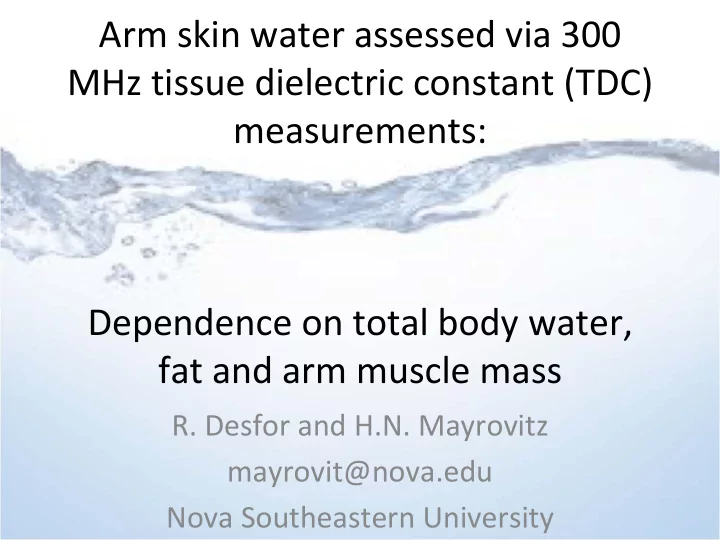

Arm skin water assessed via 300 MHz tissue dielectric constant (TDC) measurements: Dependence on total body water, fat and arm muscle mass R. Desfor and H.N. Mayrovitz mayrovit@nova.edu Nova Southeastern University
Background • Skin TDC values depend on free and bound water in the tissue • TDC values have been used to help detect lymphedema associated with breast cancer treatment and to evaluate other edematous conditions
Unilateral lymphedema
Unilateral lymphedema • When only one arm is affected, we have a normal arm to use as a control • These TDC arm ratios can be used to screen patients who may be at risk for developing lymphedema • TDC arm ratios are not helpful for bilateral cases
Bilateral lymphadema • How do we evaluate a patient without a “control” limb? We must use absolute TDC values
What parameters are quantifiably linked to TDC values? • We believe that tissue water likely varies with total body fat and water • Until now, there has been no systemic determination of possible TDC dependencies on percentages of total body water (TBW%), total body fat (FAT%), arm muscle mass (MM) or percentage arm fat (FATARM%)
Methods SUBJECTS: • 30 male and 30 female adult seated subjects • Age 28.0 ± 9.8 years
Measurements: • Bilateral anterior forearm and bicep TDC measurements to depths of 1.5 and 2.5 mm below the epidermis to determine tissue water MoistureMeterD: Small 1.5 mm probe Medium 2.5 mm probe
Ironman Innerscan Bioimpedance Scale used to determine TBW%, MM%, FAT% and FATARM%
Results Inverse relationship between TBW% and FAT%, as expected TBW% vs. FAT% 80 70 TBW% = ‐ 0.643(FAT%) + 70.5 60 N = 65 R = 0.984 TBW% 50 40 30 20 0 10 20 30 40 50 60 70 80 FAT%
Results • TDC values at forearm and biceps are most strongly positively correlated to MM% at forearm and bicep and are significantly negatively correlated to FATARM%. • TDC values are positively correlated with TBW% and negatively correlated to FAT%
Results • Strongest correlations were for forearm 1.5 mm depth TDC values yielding linear regression equations: • TDC= 0.465 (TBW%) + 7.94 (r=0.700) • TDC= ‐ 0.319(FAT%) + 41.2 (r=0.736)
Forearm TDC AT 1.5 mm Depth 45 TDC = 0.471(TBW%) + 10.3 N = 65 R = 0.661 40 35 TDC 30 25 20 20 30 40 50 60 70 80 TBW%
Forearm TDC AT 1.5 mm Depth 45 TDC = ‐ 0.286(FAT%) + 40.1 N = 65 R = 0.693 40 35 TDC 30 25 20 0 10 20 30 40 50 60 70 80 FAT%
Conclusions When absolute TDC values are needed, our findings provide a basis to individualize TDC reference values using a patient’s body habitus, including their TBW% and FAT%
Questions?
Recommend
More recommend